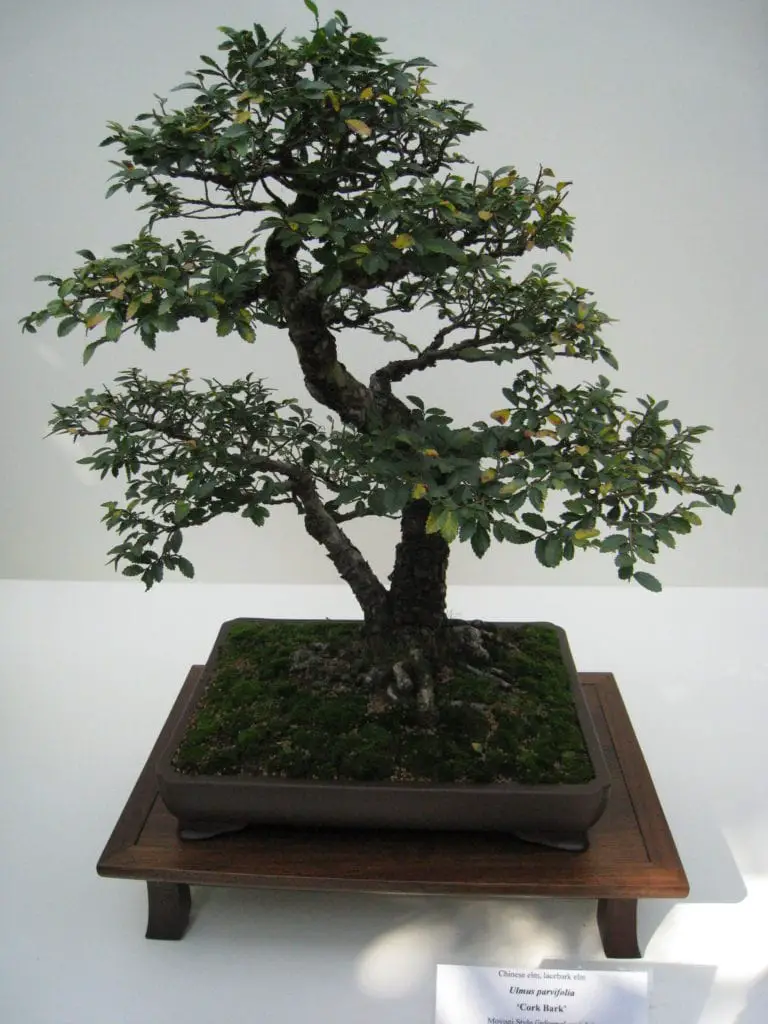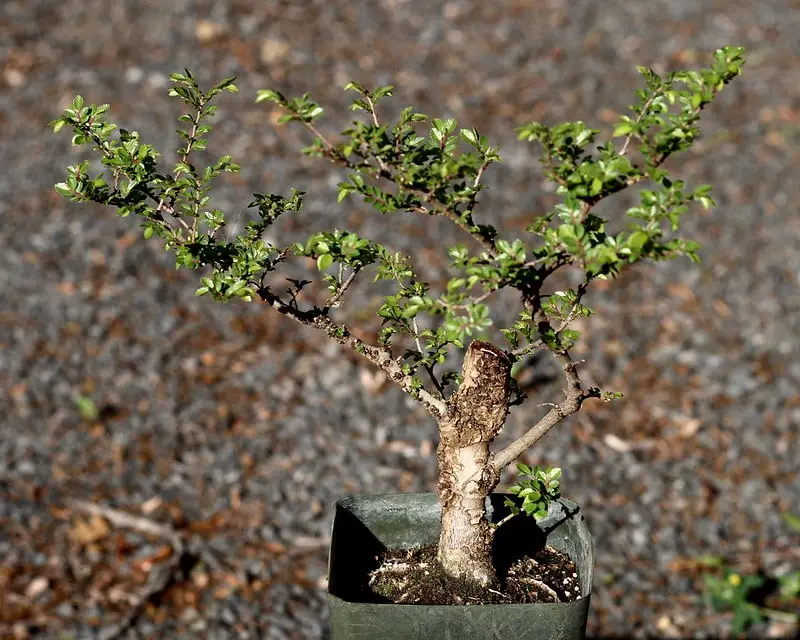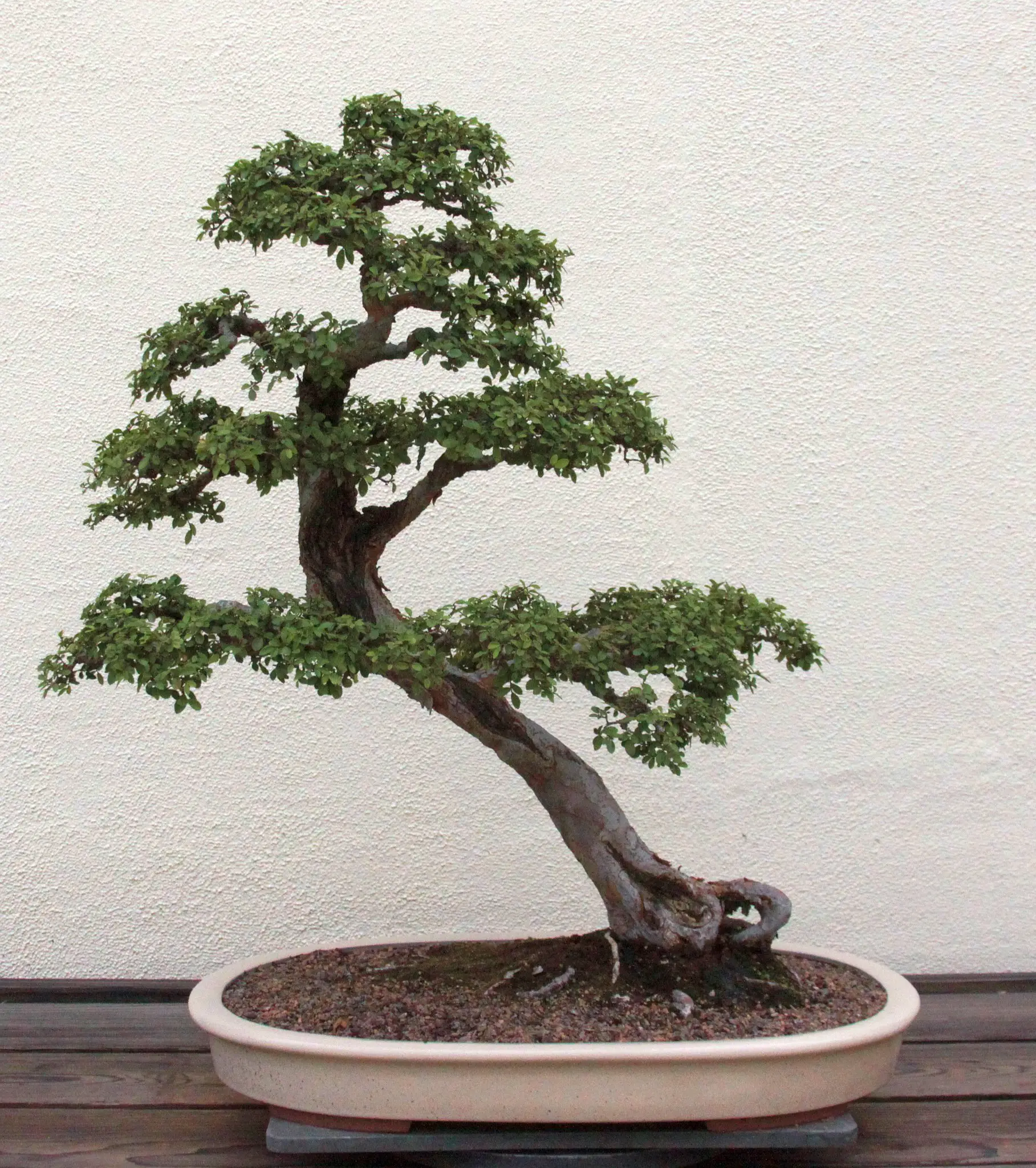Chinese elms are native to Korea, Japan, and China, and are extremely popular, especially among beginner bonsai tree enthusiasts. In this article, I will discuss how to take care of a Chinese Elm bonsai tree.
The Chinese Elm bonsai tree is one of the most attractive bonsai. They are by far the largest number of bonsai sold in the UK, in Europe, and most probably in the world. You can identify Chinese Elms by their beautiful twisting trunk, small green leaves, strong branches, and fine twigs.
Chinese Elms leaves are about two to six centimeters long. They are serrated, they have teeth marks all around the edges. Chinese Elms are naturally deciduous plants, so they shed leaves in the Autumn/ Winter. But if you grow them indoors they will remain a magnificent shade of evergreen.
They have a beautiful contrast between the thick and sturdy tree trunk all the way to the extremely delicate branches.
Chinese elm bark is thin and can easily get damaged from mechanical impact. With growing trees these bark droop.
They come in many different sizes from small (15 cm) to medium (45 cm), to larger ones which are about two feet tall.

Chinese Elm Bonsai Tree Care (in General)
Watering Your Chinese Elm Bonsai:
Water your Chinese Elm bonsai tree once every four or five days. As they are mainly indoor bonsai, water requirements for Chinese Elms will be far less than the outdoor ones.
Before watering your bonsai, always check the moisture level of the soil. A moisture meter like this one will give you the perfect idea as to when you need to water your bonsai. Alternatively, you can use a chopstick and insert it into the soil, about one and a half inches.
Now get that chopstick out touch the end and see if you find any moisture. If it is dry, then it’s time to water the bonsai.
If you are using green moss there are some things you need to remember while watering your Chinese Elms.
Green moss is no doubt beautiful, and it can make your bonsai tree look more artistic. But the main purpose of using green moss is to keep the water inside the bonsai pot and prevent it from drying out fast.
So if you’re watering through green moss, make sure that a good amount of water is coming out from the bottom of the pot. If the bonsai gets too wet, it will cause root rot and fungal diseases.
Positioning/Location:
Though the Chinese Elm is primarily an indoor bonsai tree, it loves light. Put your Chinese Elm in a sunny location but make sure it does not get beamed with direct sunlight, especially in the summers. They can get a sunburn.
The great part about the Chinese Elm is that it can handle both sunny and shady conditions well. As long as it’s not getting cooked it will survive.
Humidity:
Humidity is an important part of the growth cycle of any bonsai and Chinese Elms are no exception.
Without the proper amount of humidity, the Chinese elm will wither up and die.
To achieve the desired humidity, use humidity trays. Place the tray right underneath the bonsai tree. It will ensure you get a high level of humidity.
Remember, your bonsai pot should never sit directly in water; if the roots get submerged they will rot.
Feeding Your Chinese Elm:
Feeding is very important for bonsai trees. As the bonsai grows in a tiny amount of soil, it is crucial that you replenish its nutrients regularly. Learn more about bonsai fertilizers in this article.
The Chinese elm is not a heavy feeder, you only need to feed it every three or four months. The best fertilizer for Chinese Elm bonsai is the one with low nitrogen content. You can apply both solid and liquid fertilizers to feed your Chinese Elms.
If you’re using a solid fertilizer or a pellet-based fertilizer, feed the bonsai every two months. Whereas feed it every two to 15 days, if you’re using a liquid fertilizer.
Feed well During the growing season and avoid fertilizing your Chinese Elm bonsai during dormancy.
Pruning Chinese Elms:
Pruning and trimming your bonsai keeps it in a miniature form. If you let the Chinese Elm grow freely, it will thicken rapidly.
The best time to prune Chinese Elms is either a month after or a month before re-potting. It responds well to frequent trimming and produces a dense ramification.
If you bought Chinese elm bonsai chances are that the bonsai will have been styled and pruned before dispatch. So you should notice that the new shoots are a slightly paler green color. Never remove all of the new growth.
The leaves grow in pairs on either side of the small shoot. Leave one pair of new leaves on each shoot and prune off anything longer than this. This stops the bonsai from getting straggly and out of shape. It also allows Chinese Elms to grow slowly.
While pruning Chinese Elm bonsai, always use a very sharp pair of bonsai pruning scissors. If the cuts are made with sharp scissors it will heal quickly and prevent further disease.
If the bonsai gets out of shape, spring and summer are good times to hard prune. Don’t worry, your Chinese Elm will be budding back in no time.
Re-potting:
Just like any other bonsai The Chinese Elm also needs re-potting from time to time. In their younger days, the frequency of re-potting is once every couple of years. As the bonsai gets older, you can reduce its frequency of re-potting.
Early spring months before the opening of new buds on the tree are the best times for re-potting Chinese Elm bonsai trees.
While re-potting, you have to prune the roots. Bonsai root pruning is very important. Learn the detailed steps in this article.
Pest and Diseases:
Chinese Elm bonsai are susceptible to the same pests and diseases just like any other houseplant. To battle this your best bet is to keep your plant happy and healthy.
- Make sure there is proper air circulation in your bonsai.
- Keep the leaves free from dust and dirt.
- Check for visible insects or symptoms like abnormal leaf drop, and stickiness to the foliage.
One of the most common pests of Chinese Elm is spider mites. If you find any abnormality in your bonsai, take immediate steps. Common organic pest control methods like spraying leaves and stems with neem oil or insecticidal soaps are pretty good at fighting these problems.

Common Health Problems of Chinese Elm Bonsai:
Following are some of the most common health problems for the Chinese Elm Bonsai Tree and their probable solutions:
Yellow leaves on Chinese Elm:
The chances are the Elm is not getting proper light and humidity. The solution to this problem can be as simple as getting the location right.
Put your Chinese Elm bonsai in a bright location, away from radiators, and set the humidity right. Not too much water but not too little either.
Little Flies all over the bonsai tree:
To get rid of them use any method that gets rid of them from other plants. Organic pest control techniques can be really helpful.
Long, leggy, and weak growth on my bonsai tree:
Its location again! Chinese Elms that grow outdoors tend to have tight growth and nice small leaves. Chinese Elms grown indoors tend to have larger leaves as they have to hoover up for more sunlight. And also longer, leggier shoots to get to the light.
Weak or no growth in my Chinese Elm:
The solution is to give the plant some time outside in the sun and fresh air.
Bonsai Tree Care is both art and science. And after reading this post I am sure you are more confident to try your hands on a Chinese Elm bonsai. You can read more articles on bonsai tree care here.
